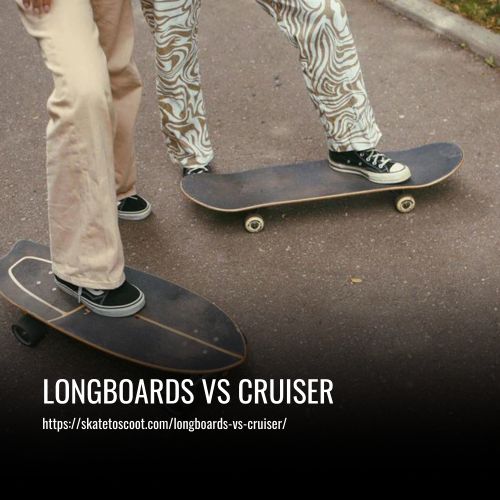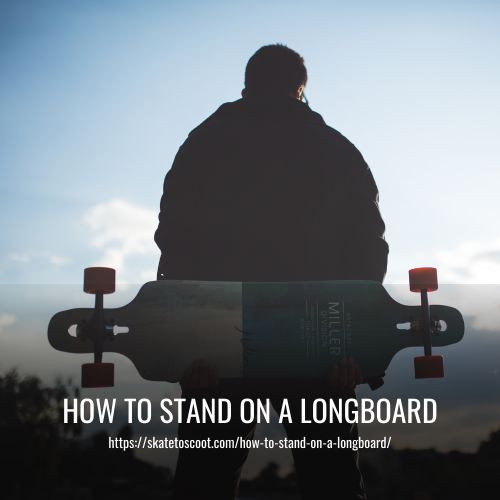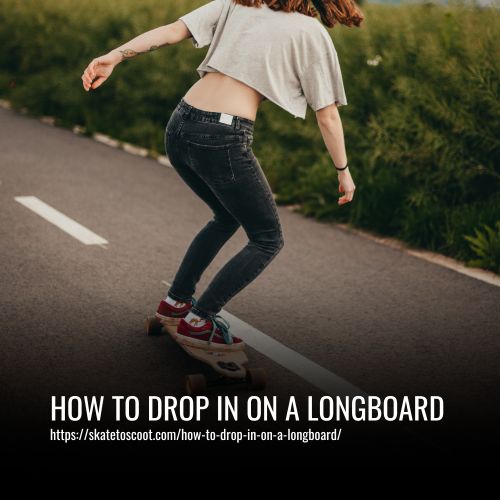As an Amazon Associate we earn from qualifying purchases.
Longboards and cruisers are both types of skateboards, but they have some key differences.
Longboards are typically longer and wider than cruisers, which gives them more stability and control. They are designed for cruising and carving, making them great for long-distance rides and downhill racing. Longboards also have larger wheels, which provide a smoother ride and better traction.
Cruisers, on the other hand, are smaller and more compact. They are designed for quick rides and maneuverability in tight spaces. Cruisers usually have smaller wheels, which make them better for tricks and jumps.
Ultimately, the choice between a longboard and a cruiser depends on your personal preference and the type of riding you want to do. If you’re looking for a smooth and stable ride for long distances, a longboard may be the better choice. If you’re more interested in tricks and quick rides, a cruiser might be more suitable.

Longboards vs Cruiser
When it comes to choosing a skateboard, there are two popular options to consider: longboards and cruisers. While they may seem similar at first glance, there are some key differences to keep in mind.
In terms of design, longboards typically have a larger deck size compared to cruisers. This allows for more stability and a comfortable riding position, making them ideal for cruising and downhill riding. On the other hand, cruisers tend to have a smaller deck size, which makes them more portable and maneuverable in crowded areas.
Riding Styles and Maneuverability:
- Longboards: Designed for more aggressive riding styles, longboards excel in downhill racing and carving. With their larger deck size, wider trucks, and softer wheels, longboards offer stability and control at high speeds. However, they may have a larger turning radius, making them less maneuverable in tight urban spaces.
- Cruisers: Cruisers are well-suited for relaxed cruising, commuting, and basic tricks. Their smaller size and narrower trucks allow for easy maneuverability in crowded areas and tight spaces. While not as suitable for aggressive riding styles or high-speed downhill racing, cruisers offer a comfortable and nimble riding experience for city streets and sidewalks.
Portability and Distance Travel:
- Longboards: While longboards are heavier and bulkier compared to cruisers, they excel in longer-distance travel and riding at higher speeds. Their size and weight contribute to efficient pushing and the ability to maintain speed over extended distances. Longboards are less portable but offer a stable and smooth ride for those seeking longer rides or downhill adventures.
- Cruisers: Designed for short-to-medium distance transportation, cruisers are lightweight and portable. They are easy to carry around in various settings, including stores, offices, restaurants, and public transportation. Due to their smaller size and agility, cruisers provide convenient city transport and are suitable for navigating through busy streets and sidewalks.
Wheel Choices and Riding Comfort:
- Longboards: Longboards typically feature larger and softer wheels, which contribute to a smoother ride and better grip on different surfaces. The softer wheels absorb shocks and vibrations, enhancing riding comfort even on rough pavements. They are designed to provide stability and control, making them ideal for various riding conditions.
- Cruisers: Cruisers often have smaller and harder wheels, which offer better speed and slide control. While they may not provide the same level of comfort as longboards on rough pavements, their wheels contribute to agility and maneuverability. The overall design of cruisers, including wider decks and single kicks, also enhances foot space and contributes to a more comfortable riding experience compared to traditional street skateboards.
Deck Size and Turning Ability:
- Cruiser boards: Cruiser boards usually have shorter decks, ranging from 28″ to 34″ in length and narrower widths of up to 9″. This compact size allows for quick and agile maneuverability, perfect for avoiding obstacles and cracks in urban settings.
- Longboards: Longboards, on the other hand, have larger decks, typically ranging from 36″ to 42″ in length and widths of 8.5″ to 10″. Their longer decks provide a wider turning arc, making them more suitable for cruising and carving at higher speeds.
Stability and Speed:
- Cruiser boards: While cruisers excel in agility, they can be less stable at higher speeds due to their shorter wheelbase and looser trucks. This can result in speed wobbles when going down steep hills, making them better suited for relaxed cruising rather than downhill racing.
- Longboards: Longboards offer superior stability, thanks to their longer wheelbase and tighter trucks. This stability allows riders to maintain control and balance even at high speeds, making longboards ideal for downhill riding and racing.
Deck Flexibility and Trick Potential:
- Cruiser boards: Cruiser boards typically have stiffer decks, providing more “pop” for performing kick tricks and manuals. Although trick possibilities are somewhat limited compared to street skateboards, cruisers still allow for basic tricks like kickflips and hopping curbs.
- Longboards: Longboards may have flexible decks that enhance cruising comfort on rough terrain and help with carving. While longboards can accommodate some freestyle tricks and dancing, their focus is more on manuals, classic freestyle, stepping, and dancing tricks.
Shape and Wheel Wells:
- Cruiser boards: Cruiser boards often have a surfboard-like shape, with a directional design featuring a squared or rounded square tail and a pointy nose. They may also include a kicktail for performing kick tricks. Wheel flares and narrower noses help reduce the chances of wheel bite, allowing for tight carving and fast turning.
- Longboards: Longboards come in various shapes, with common options being pintail-shaped or symmetrical cutout-shaped decks. While some longboards may have a kicktail for freestyling or dancing tricks, the focus is primarily on cruising, carving, and distance pushing. Wheel clearance can vary depending on the specific longboard model.
Other Considerations:
- Truck Mount: Cruisers are typically top-mounted, making them harder to push and less stable at higher speeds. Some full-sized longboards can be either top-mounted or drop-through, with drop-through offering more stability at downhill speed.
- Trucks: Mini-cruisers use traditional kingpin trucks for nimble movements, while longboards use reverse kingpin trucks for stability at higher speeds.
- Wheels: Cruisers often have smaller, soft wheels for good grip and shock absorption. Longboards may have bigger wheels for higher speeds, with the option for harder wheels for sliding.
Skateboard vs cruiser
Skateboards and cruisers are both types of boards used for riding and cruising, but there are some key differences between them.
Skateboards typically have a deck length of 30-32″ and a width of 7.5-8.5″. They are similar in size to many cruiser boards, although mini-cruisers are often smaller. However, skateboards tend to have a narrower width than cruiser boards and a double-kick popsicle shape, compared to the single-kick surfboard shape of most cruisers.
One major difference between skateboards and cruisers is the type of wheels they use. Cruisers are designed to accommodate larger and softer wheels, making cruising more comfortable. On the other hand, skateboards typically use smaller and harder wheels, which are better for tricks and street skating.
Another difference is the wheelbase length. Cruisers, except for mini-cruisers, usually have longer wheelbases than skateboards. This longer wheelbase enhances stability and provides a more comfortable ride during cruising.
Longboards vs Cruiser vs Skateboard: Understanding the Differences
Whether you’re new to the skateboarding world or a seasoned rider looking to explore new options, understanding the differences between longboards, cruisers, and skateboards is crucial. Each type of board offers a unique riding experience tailored to different preferences and riding styles. Let’s break it down:
1. Size and Shape:
– Longboards: These boards are typically larger than cruisers and skateboards, offering a more spacious and comfortable riding platform. Longboards often feature a single-kick surfboard shape and a longer wheelbase, providing stability and a smooth ride.
– Cruiser: Cruiser boards fall between longboards and skateboards in terms of size. They are similar in size to skateboards but tend to have a wider deck and a single-kick surfboard shape. The wider deck and surfboard-like shape enhance stability while cruising.
– Skateboards: Skateboards are smaller in size compared to longboards and cruisers. They feature a double-kick popsicle shape, which is ideal for tricks, stunts, and street skating.
2. Trucks and Wheels:
– Longboards: Longboards utilize reverse kingpin (RKP) trucks, which are wider and taller than street trucks. RKP trucks offer a more surfy and flowy riding feel, making them ideal for fast riding and comfortable distance commuting. Longboards also come with larger wheels, providing a smoother ride over rough terrains.
– Cruisers: Similar to longboards, cruisers often use larger and softer wheels. These wheels offer a comfortable and smooth cruising experience. The trucks used in cruisers are designed for stability and maneuverability during mellow rides and carving.
– Skateboards: Skateboards typically feature traditional kingpin (TKP) trucks, which are shorter, lighter, and more suitable for street tricks, pops, grinds, ollies, and ramps. Skateboards also have smaller and harder wheels, enabling riders to perform tricks and maneuvers with ease.
3. Riding Style and Usage:
– Longboards: With their longer wheelbase, stable platform, and softer wheels, longboards are perfect for various riding styles such as freestyle, dancing, and downhill riding. They excel at providing a smooth and comfortable ride over long distances.
– Cruisers: Cruisers are great for casual cruising, commuting, and relaxed rides. Their wider deck and comfortable wheels make them suitable for riders who prioritize comfort and stability.
– Skateboards: Designed for street and park slashing, skateboards are well-suited for performing tricks, flips, slides, and grinds. They offer more maneuverability and agility, making them ideal for skatepark sessions and street riding.
Things To Consider When Choosing A Longboard Or Cruiser
When choosing between a longboard and a cruiser, there are a few things to consider to make the right decision for your riding style and preferences.
Firstly, think about the type of terrain you want to ride on. If you’re in the mood for ollies and kicktail tricks, a cruiser board may be more suitable. Cruisers are great for street tricks and maneuvers, providing more maneuverability and agility. On the other hand, if you’re looking to dive into deep carves and enjoy a smooth ride, a longboard is the way to go. Longboards excel at providing stability and a comfortable cruising experience, making them ideal for downhill riding and long-distance journeys.
Keep in mind that both longboards and cruisers can be ridden on the same spot, offering an amazing experience in their own ways. While you may think you chose the wrong board for a specific occasion, it’s all about creativity and finding ways to use your board’s unique characteristics to your advantage. This exploration will help you become a more well-rounded skater and diversify your riding styles.
So Which Is Better?
So Which Is Better? When it comes to choosing between a longboard and a cruiser board, there is no “better” option. It all comes down to personal preference and the kind of experience you’re looking for.
If you’re into ollies and kicktail tricks, a cruiser board might be more suitable for you. These boards are great for street tricks and maneuvers, offering more maneuverability and agility. On the other hand, if you prefer deep carves and a smooth ride, a longboard is the way to go. Longboards excel at providing stability and a comfortable cruising experience, making them ideal for downhill riding and long-distance journeys.
But here’s the thing: both longboards and cruisers can be ridden on the same spot, and they offer unique experiences in their own ways. Don’t worry if you think you chose the wrong board for a specific occasion. Embrace the opportunity to get creative and find ways to use your board’s unique characteristics to your advantage. This exploration will make you a more well-rounded skater and diversify your riding styles.
FAQs
Longboards typically have a longer deck with a wider shape, providing more stability and smooth rides. They are designed for cruising, downhill riding, and long-distance journeys. Cruisers, on the other hand, have shorter and narrower decks with kicktails, making them more suitable for street tricks and maneuvers.
Longboards are ideal for riders who enjoy deep carves, downhill riding, and comfortable cruising experiences. They are perfect for those seeking stability and a smooth ride. Cruisers, with their maneuverability and agility, are great for street tricks, ollies, and kicktail maneuvers.
Yes, both longboards and cruisers can be ridden on the same spots. While they offer distinct riding experiences, it is possible to get creative with your board’s characteristics and utilize them to your advantage in different scenarios.
Conclusion:
Longboards and cruisers are both capable of giving you the freedom of a skateboard but with different riding styles. Longboards offer a smooth ride and more speed for downhill carving or cruising while cruisers are great for transportation and short-distance commuting.
Ultimately, it’s really up to your personal preference as to which style you choose—it just depends on what type of riding experience you’re looking for. So find the perfect board that suits your needs and have fun out there!
Amazon and the Amazon logo are trademarks of Amazon.com, Inc, or its affiliates.



